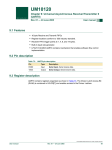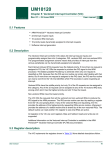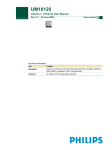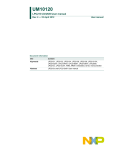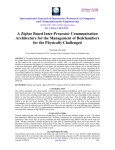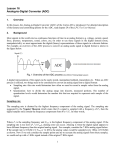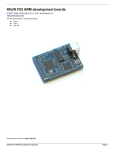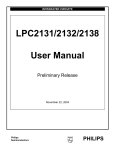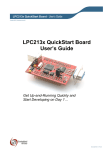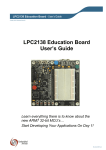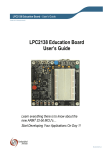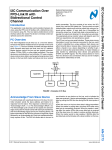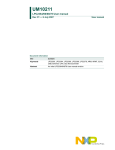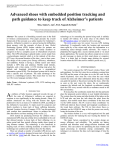Download UM10120 Volume 1: LPC213x User Manual
Transcript
UM10120 Chapter 16: Analog-to-Digital Converter (ADC) Rev. 01 — 24 June 2005 User manual 16.1 Features • 10 bit successive approximation analog to digital converter (one in LPC2131/2 and two in LPC2134/6/8). • • • • • • • Input multiplexing among 8 pins. Power-down mode. Measurement range 0 to 3 V. 10 bit conversion time ≥ 2.44 µs. Burst conversion mode for single or multiple inputs. Optional conversion on transition on input pin or Timer Match signal. Global Start command for both converters (LPC2134/6/8 only). 16.2 Description Basic clocking for the A/D converters is provided by the VPB clock. A programmable divider is included in each converter, to scale this clock to the 4.5 MHz (max) clock needed by the successive approximation process. A fully accurate conversion requires 11 of these clocks. 16.3 Pin description Table 161 gives a brief summary of each of ADC related pins. Table 161: ADC pin description Pin Type Description AD0.7:0 & AD1.7:0 (LPC2134/6/8) Input Analog Inputs. The A/D converter cell can measure the voltage on any of these input signals. Note that these analog inputs are always connected to their pins, even if the Pin Multiplexing Register assigns them to port pins. A simple self-test of the A/D Converter can be done by driving these pins as port outputs. Note: if the A/D converter is used, signal levels on analog input pins must not be above the level of V3A at any time. Otherwise, A/D converter readings will be invalid. If the A/D converter is not used in an application then the pins associated with A/D inputs can be used as 5 V tolerant digital IO pins. Warning: while the ADC pins are specified as 5 V tolerant (see Table 56 “Pin description” on page 67), the analog multiplexing in the ADC block is not. More than 3.3 V (VDDA) +10 % should not be applied to any pin that is selected as an ADC input, or the ADC reading will be incorrect. If for example AD0.0 and AD0.1 are used as the ADC0 inputs and voltage on AD0.0 = 4.5 V while AD0.1 = 2.5 V, an excessive voltage on the AD0.0 can cause an incorrect reading of the AD0.1, although the AD0.1 input voltage is within the right range. Vref Reference Voltage Reference. This pin is provides a voltage reference level for the A/D converter(s). VDDA, VSSA Power Analog Power and Ground. These should be nominally the same voltages as VDD and VSS, but should be isolated to minimize noise and error. © Koninklijke Philips Electronics N.V. 2005. All rights reserved. User manual Rev. 01 — 24 June 2005 193 UM10120 Philips Semiconductors Volume 1 Chapter 16: A/D Converter 16.4 Register description The A/D Converter registers are shown in Table 162. Table 162: ADC registers Generic Description Name Access Reset value[1] AD0 Address & Name AD1 Address & Name ADCR A/D Control Register. The ADCR register must be written R/W to select the operating mode before A/D conversion can occur. 0x0000 0001 0xE003 4000 0xE006 0000 AD0CR AD1CR ADDR A/D Data Register. This register contains the ADC’s DONE bit and (when DONE is 1) the 10-bit result of the conversion. undefined R/W ADGSR A/D Global Start Register. This address can be written (in WO the AD0 address range) to start conversions in both A/D converters simultaneously. [1] 0x00 0xE003 4004 0xE006 0004 AD0DR AD1DR 0xE003 4008 ADGSR Reset value relects the data stored in used bits only. It does not include reserved bits content. 16.4.1 A/D Control Register (AD0CR - 0xE003 4000 and AD1CR 0xE006 0000) Table 163: A/D Control Register (AD0CR - address 0xE003 4000 and AD1CR - address 0xE006 0000) bit description Bit Symbol Value Description 7:0 SEL Selects which of the AD0.7:0/AD1.7:0 pins is (are) to be sampled and converted. For 0x01 AD0, bit 0 selects Pin AD0.0, and bit 7 selects pin AD0.7. In software-controlled mode, only one of these bits should be 1. In hardware scan mode, any value containing 1 to 8 ones. All zeroes is equivalent to 0x01. 15:8 CLKDIV The VPB clock (PCLK) is divided by (this value plus one) to produce the clock for the 0 A/D converter, which should be less than or equal to 4.5 MHz. Typically, software should program the smallest value in this field that yields a clock of 4.5 MHz or slightly less, but in certain cases (such as a high-impedance analog source) a slower clock may be desirable. 16 BURST 1 Reset value The AD converter does repeated conversions at the rate selected by the CLKS field, 0 scanning (if necessary) through the pins selected by 1s in the SEL field. The first conversion after the start corresponds to the least-significant 1 in the SEL field, then higher numbered 1-bits (pins) if applicable. Repeated conversions can be terminated by clearing this bit, but the conversion that’s in progress when this bit is cleared will be completed. Important: START bits must be 000 when BURST = 1 or conversons will not start. 0 Conversions are software controlled and require 11 clocks. © Koninklijke Philips Electronics N.V. 2005. All rights reserved. User manual Rev. 01 — 24 June 2005 194 UM10120 Philips Semiconductors Volume 1 Chapter 16: A/D Converter Table 163: A/D Control Register (AD0CR - address 0xE003 4000 and AD1CR - address 0xE006 0000) bit description Bit Symbol Value Description 19:17 CLKS 20 - 21 PDN Reset value This field selects the number of clocks used for each conversion in Burst mode, and the 000 number of bits of accuracy of the result in the LS bits of ADDR, between 11 clocks (10 bits) and 4 clocks (3 bits). 000 11 clocks / 10 bits 001 10 clocks / 9bits 010 9 clocks / 8 bits 011 8 clocks / 7 bits 100 7 clocks / 6 bits 101 6 clocks / 5 bits 110 5 clocks / 4 bits 111 4 clocks / 3 bits Reserved, user software should not write ones to reserved bits. The value read from a reserved bit is not defined. NA 1 The A/D converter is operational. 0 0 The A/D converter is in power-down mode. 23:22 - Reserved, user software should not write ones to reserved bits. The value read from a reserved bit is not defined. NA 26:24 START When the BURST bit is 0, these bits control whether and when an A/D conversion is started: 0 27 000 No start (this value should be used when clearing PDN to 0). 001 Start conversion now. 010 Start conversion when the edge selected by bit 27 occurs on P0.16/EINT0/MAT0.2/CAP0.2 pin. 011 Start conversion when the edge selected by bit 27 occurs on P0.22/TD3/CAP0.0/MAT0.0 pin. 100 Start conversion when the edge selected by bit 27 occurs on MAT0.1. 101 Start conversion when the edge selected by bit 27 occurs on MAT0.3. 110 Start conversion when the edge selected by bit 27 occurs on MAT1.0. 111 Start conversion when the edge selected by bit 27 occurs on MAT1.1. EDGE 31:28 - This bit is significant only when the START field contains 010-111. In these cases: 1 Start conversion on a falling edge on the selected CAP/MAT signa. 0 Start conversion on a rising edge on the selected CAP/MAT signal. Reserved, user software should not write ones to reserved bits. The value read from a reserved bit is not defined. 0 NA © Koninklijke Philips Electronics N.V. 2005. All rights reserved. User manual Rev. 01 — 24 June 2005 195 UM10120 Philips Semiconductors Volume 1 Chapter 16: A/D Converter 16.4.2 A/D Data Register (AD0DR - 0xE003 4004 and AD1DR - 0xE006 0004) Table 164: A/D Data Register (AD0DR - address 0xE003 4004 and AD1DR - address 0xE006 0004) bit description Bit Symbol Description Reset value 5:0 - Reserved, user software should not write ones to reserved bits. The value read from NA a reserved bit is not defined. 15:6 V/VREF When DONE is 1, this field contains a binary fraction representing the voltage on NA the Ain pin selected by the SEL field, divided by the voltage on the VDDA pin. Zero in the field indicates that the voltage on the Ain pin was less than, equal to, or close to that on VSSA, while 0x3FF indicates that the voltage on Ain was close to, equal to, or greater than that on VREF. 23:16 - Reserved, user software should not write ones to reserved bits. The value read from NA a reserved bit is not defined. 26:24 CHN These bits contain the channel from which the LS bits were converted (e.g. 000 identifies channel 0, 001 channel 1...). 29:27 - Reserved, user software should not write ones to reserved bits. The value read from NA a reserved bit is not defined. 30 OVERUN This bit is 1 in burst mode if the results of one or more conversions was (were) lost and overwritten before the conversion that produced the result in the LS bits. In non-FIFO operation, this bit is cleared by reading this register. 0 31 DONE This bit is set to 1 when an A/D conversion completes. It is cleared when this register is read and when the ADCR is written. If the ADCR is written while a conversion is still in progress, this bit is set and a new conversion is started. 0 NA 16.4.3 A/D Global Start Register (ADGSR - 0xE003 4008) Software can write this register to simultaneously initiate conversions on both A/D controllers. This register is available in LPC2134/6/8 devices only. Table 165: A/D Global Start Register (ADGSR - address 0xE003 4008) bit description Bit Symbol 15:0 - 16 BURST Value Description Reset value Reserved, user software should not write ones to reserved bits. The value read from a reserved bit is not defined. 1 NA The AD converters do repeated conversions at the rate selected by their CLKS fields, 0 scanning (if necessary) through the pins selected by 1s in their SEL field. The first conversion after the start corresponds to the least-significant 1 in the SEL field, then higher numbered 1-bits (pins) if applicable. Repeated conversions can be terminated by clearing this bit, but the conversion that’s in progress when this bit is cleared will be completed. Important: START bits must be 000 when BURST = 1 or conversons will not start. 0 23:17 - Conversions are software controlled and require 11 clocks. Reserved, user software should not write ones to reserved bits. The value read from a reserved bit is not defined. NA © Koninklijke Philips Electronics N.V. 2005. All rights reserved. User manual Rev. 01 — 24 June 2005 196 UM10120 Philips Semiconductors Volume 1 Chapter 16: A/D Converter Table 165: A/D Global Start Register (ADGSR - address 0xE003 4008) bit description Bit Symbol Value Description 26:24 START 27 Reset value When the BURST bit is 0, these bits control whether and when an A/D conversion is started: 000 No start (this value should be used when clearing PDN to 0). 001 Start conversion now. 010 Start conversion when the edge selected by bit 27 occurs on P0.16/EINT0/MAT0.2/CAP0.2 pin. 011 Start conversion when the edge selected by bit 27 occurs on P0.22/TD3/CAP0.0/MAT0.0 pin. 100 Start conversion when the edge selected by bit 27 occurs on MAT0.1. 101 Start conversion when the edge selected by bit 27 occurs on MAT0.3. 110 Start conversion when the edge selected by bit 27 occurs on MAT1.0. 111 Start conversion when the edge selected by bit 27 occurs on MAT1.1. EDGE This bit is significant only when the START field contains 010-111. In these cases: 1 Start conversion on a falling edge on the selected CAP/MAT signal. 0 Start conversion on a rising edge on the selected CAP/MAT signal. 31:28 - Reserved, user software should not write ones to reserved bits. The value read from a reserved bit is not defined. 0 0 NA 16.5 Operation 16.5.1 Hardware-triggered conversion If the BURST bit in the ADCR is 0 and the START field contains 010-111, the A/D converter will start a conversion when a transition occurs on a selected pin or Timer Match signal. The choices include conversion on a specified edge of any of 4 Match signals, or conversion on a specified edge of either of 2 Capture/Match pins. The pin state from the selected pad or the selected Match signal, XORed with ADCR bit 27, is used in the edge detection logic. 16.5.2 Interrupts An interrupt request is asserted to the Vectored Interrupt Controller (VIC) when the DONE bit is 1. Software can use the Interrupt Enable bit for the A/D Converter in the VIC to control whether this assertion results in an interrupt. DONE is negated when the ADDR is read. 16.5.3 Accuracy vs. digital receiver The AIN function must be selected in corresponding Pin Select register (see "Pin Connect Block" on page 73) in order to get accurate voltage readings on the monitored pin. For pin hosting an ADC input, it is not possible to have a have a digital function selected and yet get valid ADC readings. An inside circuit disconnects ADC hardware from the associated pin whenever a digital function is selected on that pin. © Koninklijke Philips Electronics N.V. 2005. All rights reserved. User manual Rev. 01 — 24 June 2005 197





